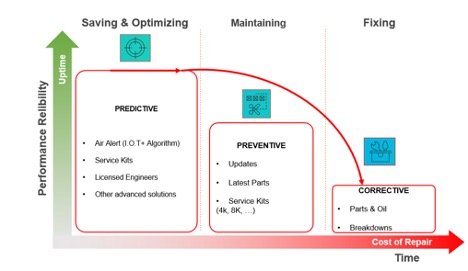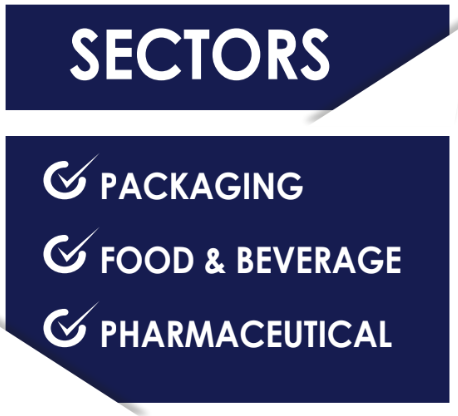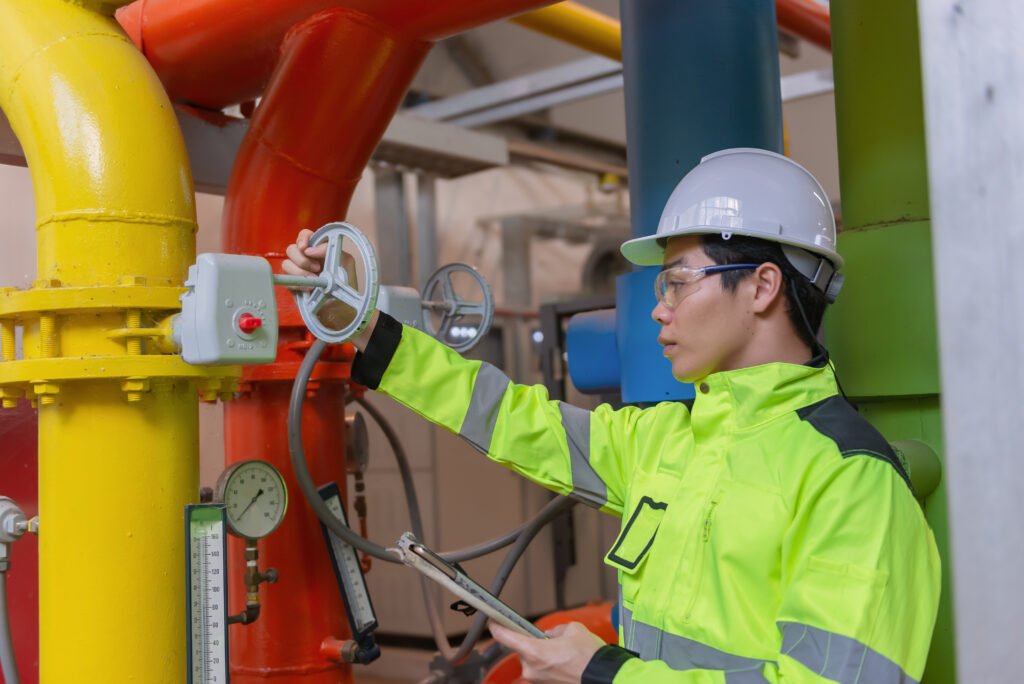Looking into how – with a tailored approach to maintenance, we can predict the lifetime of a system and know when preventive maintenance should happen.
By Roger Savo, Aftermarket Director, Europe at ELGi
In today’s fast-paced industrial environment where downtime equates to significant financial losses and operational inefficiencies, implementing predictive and preventive maintenance (PPM) has become not just an option, but a necessity for companies across all sectors. This integrated strategy not only enhances the reliability and performance of equipment, but also extends its operational life ensuring both efficiency and durability in industrial operations in a manner that underscores cost-effectiveness.


What is predictive maintenance and what are its key components?
Predictive maintenance is an advanced maintenance strategy that leverages data analytics, machine learning, and sensor technologies to predict and prevent equipment failures before they occur. Unlike traditional maintenance approaches, such as reactive maintenance (fixing issues after they happen) or preventive maintenance (scheduled maintenance regardless of equipment condition), predictive maintenance focuses on data-driven insights to optimise maintenance schedules and maximise equipment uptime and reliability.
Connected new technologies play a crucial role in driving the efficiency of predictive maintenance. By integrating sensors and networks with analytics and augmented intelligence tools, predictive maintenance systems can offer more accurate predictions and real-time insights.
Call-out box
ELGi’s Air~Alert is an IoT-based, smart 24/7 remote machine monitoring and alert system which can be implemented on new and existing installations. The service enables customers to act in time to avoid potential failures of compressors with 24/7 remote monitoring of a compressed air system. It does this by delivering trend graphs and information about operating parameters including discharge pressure, oil temperature, variable frequency drive (VFD) speed, total running hours, trips, and alerts on a live online interface accessible remotely from anywhere in the world. Air~Alert also functions as a predictive maintenance system notifying customers and ELGi Channel Partners about scheduled maintenance, fault occurrence, and predicts commonly occurring failures. Monthly summary reports on overall health and operating parameters include upcoming planned service requirements, as well as preventative maintenance based on system data.
Smart technology integrations allow for “always-on” agility, where unforeseen machinery conditions can be addressed promptly, thus mitigating potential damage and optimising decision-making processes. Connectivity facilitates a comprehensive data exchange, enhancing the predictive analysis and enabling more informed, strategic decisions regarding asset maintenance.



Key components of Predictive and Preventative Maintenance (PPM) systems:
Implementing preventive maintenance requires a strategic approach, underpinned by several key components:
- Advanced Sensor Technology: IoT sensors are crucial for real-time monitoring of equipment conditions, providing the data necessary for predictive analysis.
- Data Analytics and Artificial Intelligence (AI): The heart of PPM lies in data analytics and AI algorithms which process data collected by sensors to identify patterns, predict potential failures, and suggest preventive measures.
- Skilled Workforce: A workforce skilled in data analysis, machine learning, and the operation of sophisticated monitoring equipment is essential for interpreting data and implementing maintenance strategies effectively.
- Cultural Shift: Embracing PPM requires a cultural shift within the organisation, moving from a reactive to a proactive maintenance mindset. This shift involves training, change management, and ongoing support.
How Predictive Maintenance Operate:
The predictive maintenance process unfolds through several stages:
- Data Collection: Continuous monitoring and data capture from machinery.
- Data Analysis: Application of statistical techniques and machine learning to analyse the collected data.
- Anomaly Detection: Identification of data patterns that deviate from the norm, indicating potential issues.
- Prediction and Decision-Making: Use of predictive algorithms to forecast failures and decide on maintenance actions.
- Proactive Maintenance: Execution of maintenance tasks before failures occur, based on predictive insights.
Benefits of implementing PPM methodology:
The rationale for adopting the predictive and preventive maintenance methodology within business operations is underlined by its significant benefits for companies:
- Downtime Minimisation: Unplanned downtime is the bane of productivity. The adoption of predictive maintenance has been linked to a significant reduction in unplanned downtime, enhancing overall productivity. Connected technologies facilitate the predictive maintenance process, allowing for real-time insights and the efficient deployment of maintenance resources. According to Deloitte Analytics Institute Position Paper on Predictive Maintenance, this efficiency translates into a 20-50% reduction in maintenance planning time, a 10-20% increase in equipment uptime, and a 5-10% reduction in overall maintenance costs. Notably, implementations of predictive maintenance in sectors such as chemical manufacturing and transportation have led to significant decreases in downtime and maintenance costs, with one large chemical manufacturer achieving an 80% reduction in unplanned downtime and savings of around $300,000 per asset.
- Cost Reduction: PPM significantly lowers maintenance costs by identifying issues before they escalate into costly repairs or complete equipment replacements. By optimising maintenance schedules, companies can avoid unnecessary maintenance activities, saving on labour and parts. According to Advanced Technology Services (ATS), predictive maintenance yields cost savings between 8% to 12% over preventive maintenance and up to 40% over reactive maintenance. This insight underscores the financial benefits of adopting predictive maintenance strategies over traditional maintenance approaches.
- Extended Equipment Life: Regular and precise maintenance extends the operational lifespan of machinery. According to research by McKinsey, predictive maintenance can lead to a reduction in machine downtime by 30% to 50% and increase machine life by 20% to 40%. This demonstrates the significant impact that predictive maintenance strategies can have on extending the operational lifespan of machinery, enabling companies to defer capital expenditures on new equipment and optimise the return on investment for their existing assets.
- Enhanced Safety and Compliance. Implementing PPM strategies can significantly enhance workplace safety and ensure compliance with safety regulations. By proactively identifying and addressing potential equipment failures before they occur, PPM minimises the risks of accidents, creating a safer environment for employees. This proactive approach not only protects the workforce but also helps companies adhere to stringent safety standards, thereby avoiding legal and financial penalties associated with non-compliance.
- Operational Efficiency: With PPM, companies benefit from an overall increase in operational efficiency. If data is collected and analysed correctly and maintenance tasks are performed just in time, equipment wear and tear is reduced, improving the performance of equipment.
Conclusion
The implementation of predictive and preventive maintenance is not just a best practice, it’s a strategic imperative for companies aiming to thrive in the competitive and fast-evolving landscape of Industry 4.0. By adopting PPM, businesses can achieve not only significant cost savings and efficiency gains, but also enhance their operational resilience. In an era where downtime can be a critical setback and efficiency gains are continuously sought, PPM stands as a beacon of operational excellence, ensuring companies remain agile, proactive, and ahead of potential failures.

